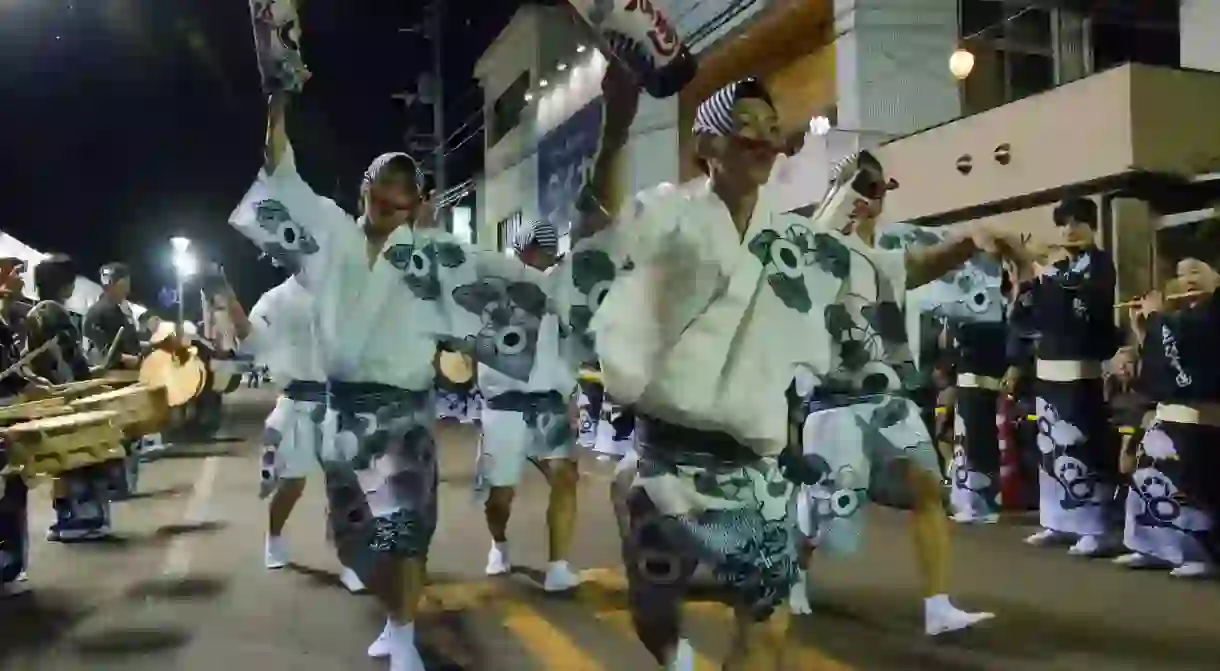The Mysterious Origins of Awa Odori

Summertime in Japan is the season of buzzing cicadas, brilliant fireworks and raucous street festivals. One of the biggest street festivals that takes place during the summer is the Awa Odori.
A centuries-old dance party that over a million people take part in around the country each year, Awa Odori is best characterized by the refrain sung and chanted by dancers:
It’s a fool who dances and a fool who watches! If both are fools, you might as well have fun dancing!
– Japan National Tourism Organization
The dance is easily recognized by its distinctive style: women dressed in traditional Japanese garb and pointed hats made of woven rushes and men dancing crouched low in a “foolish” posture, imitating the movements of drunken revelers, though it’s not unheard of for them to be a bit inebriated themselves.

Despite the dance’s popularity, however, the exact origins of Awa Odori are still up for debate. Here are four popular theories.
It started as a drunken dance party
Many people believe that Awa Odori originated from a massive celebration held in the 16th century. ‘Awa’ refers to the region known as modern-day Tokushima prefecture, on the island of Shikoku, while ‘odori’ means dance. To fête the completion of Tokushima Castle, the feudal lord of Awa province, Hachisuka Iemasa, threw the party to end all parties. The townspeople are said to have drunk so much that they swayed wildly as they danced, forming the early steps of Awa Odori.

It was born out of the Obon Festival
Obon is an annual period of remembrance and honoring one’s ancestors. Folk dances and chants have traditionally been used as a part of Buddhist custom to welcome visiting spirits and over time this evolved into people joyfully dancing accompanied by flutes, drums, prayer gongs and shamisen (a three-stringed instrument) during the three days of the Obon festival.
While praying for the deceased may seem like a solemn spiritual activity, Obon festivities could become quite rowdy. Feudal laws passed in Tokushima during the 17th century suggest that Obon dancing was something of a public disturbance there, and this may have been the direct forerunner to the modern-day Awa Odori dance.

It shares its origins with Noh theater
Noh theater is the classical style of Japanese musical drama, and one of the oldest forms of theater in the world. Noh was born out of traditional Japanese folk dances known as furyu, which featured vibrantly colored costumes and the music of gongs and taiko drums. Local records show that a furyu performance was held in Awa province as early as the 1500s, and this performance may have influenced the birth of Awa Odori in the region.

It was created to promote tourism
Whatever the origin, Awa Odori was never formally referred to by that specific name until the 20th century, when the local Tokushima government began promoting the dance as a tourist attraction for the region. Today, Tokushima hosts the largest Awa Odori festival in Japan every year in mid-August, with the second-largest festival taking place at the end of August in the Koenji district of Tokyo.
Whatever your beliefs on how it originated may be, it’s a festival worth experiencing for yourself.













